TL;DR
- VALORANT Esports is structured around the VALORANT Champions Tour (VCT), a global league system operated by Riot Games.
- The competitive path includes regional leagues, international Masters events, and the Champions finale, where the best teams compete for the world title.
- Players can progress from grassroots and open-circuit tournaments through division-based matchmaking and Challenger leagues to reach the VCT.
- Riot Games hand-picks teams for VCT participation, combining performance-based selection with a franchising model.
- Sponsorships, in-game cosmetics, and media rights drive revenue, with strict policies excluding gambling and crypto sponsors.
- Viewership and prize pools have grown year-on-year, with 2025 on track to set new records.
Have you ever wondered how VALORANT Esports works? Riot Games’ premier tactical shooter exploded into popularity as soon as it emerged on the scene five years ago, being more popular now in 2025 than ever before. There’s never been a better time to get invested in the high-stakes world of the best players, whether you want to watch intently or are considering playing at a higher level yourself.
We’ll review the competitive structure of VALORANT’s Esports scene and thoroughly analyse the current state of the VALORANT Champions Tour and local and regional events. This includes a detailed analysis of how money, sponsorship, and broadcasting work, as well as the players who take part in it.
For more, we recommend reading up on Esports Insider’s extensive VALORANT Esports coverage, which includes news stories and features on the competitive map pool, the teams making waves, slot allocation for tournaments, and the big changes rolling out to the title as they happen.
VALORANT Esports format explained – Competitive structure
VALORANT Esports is a term for the VALORANT Champions Tour (VCT), a global organisation operated by Riot Games with a franchise-based league that all teams participate in at the regional and international level, eventually going to the world championships.
Riot Games selects the franchise teams it wants to play in the VCT based on how well the VALORANT Esports teams are performing. Teams must regularly compete to be eligible for selection, with most teams playing at least once a week (and often more). The winning teams from the regular season advance to the playoffs, where they can secure a spot in the international league.
The Masters VALORANT International tournaments are where the teams compete to win Championship Points to advance further up the league table. Those with the highest points at the end of the season will play in the Champions (the global VCT finale), where only the best VALORANT teams compete for the title of World Champion.
What is the VALORANT Champions Tour (VCT)?
The VALORANT Champions Tour works across four regions: America (NA and South America), EMEA (Europe, Middle East, and Africa), the Pacific (Japan, Korea, and India), and China.
There are 42 teams across three leagues, which is 14 teams in a league. It’s believed that there are nearly 5,000 players in the VALORANT Esports scene.
Leo Faria is the current director of the VALORANT Champions Tour, which was founded alongside the game’s launch in 2020. However, its first event was not held until a year later, in 2021.
Following the first event, the VCT Game Changers was launched exclusively for women and marginalised groups not traditionally part of the usual esports scene.
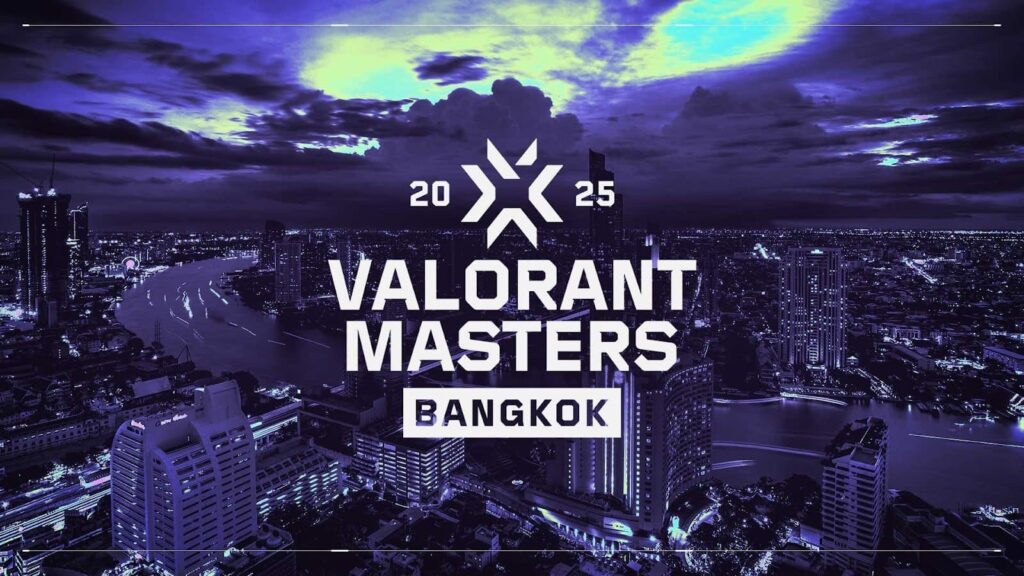
Regional leagues & competitions
In previous years, the VALORANT Esports leagues had a seven-region format. However, that’s since been simplified and streamlined to three different regions, each with its own league. This format replaced the old Challengers system, where teams competed at the domestic level to qualify for Masters and then (eventually) Champions.
The current VALORANT Champions Tour 2025 started in March and will run until late April (or May), depending on the region. China, the Americas, the Pacific, EMEA, France Revolution, Spain Rising, LATAM North ACE, NORTH/EAST, Türkiye Birlik, DACH Evolution, MENA Resilience, Southeast Asia, WDG Korea, and Oceania are among the ongoing tournaments being held around the world.
It’s split into Group Alpha and Group Omega, with Chinese teams like Nova Esports, EDward Gaming, FunPlus Phoenix, Titan Esports Club, TYLOO, Bilibili Gaming, Xi Lai Gaming, Wolves Esports, Trace Sports, JD Mall JDG Esports, and All Gamers competing against each other.
Whoever wins at the end of the first stage will advance to the second and eventually be on the board for the international events before having a shot at the Champions.
Third-party tournaments & grassroots competitions
Third-party VALORANT tournaments have cropped up in recent years to give more people the opportunity to play competitively and win cash without the needed financial backing and franchise support of the regulated teams. Some of the most well-known include Redbull Homeground, Soop VALORANT League, and Convergence 24.
Grassroots VALORANT competitions are sometimes referred to as C-Tier Tournaments, which are the lowest-ranked events and are usually played online and with little to no high-level participation.
Lesser-known events include Luxembourg’s POP Esports Masters, the UK’s Cyber Showdown, Germany’s Equal Esports Queens, as well as North American events such as College VALORANT, which is usually played by 16 teams across many different states.
The Valuable prize money from these grassroots and third-party competitions is usually quite low stakes compared to the big leagues. For example, the Lockdown Arena (comprising 52 participants) has a prize pool of $1,640, and Resurrection 2025 (based in Europe) was played for a total of $1,000 and featured 55 participants.
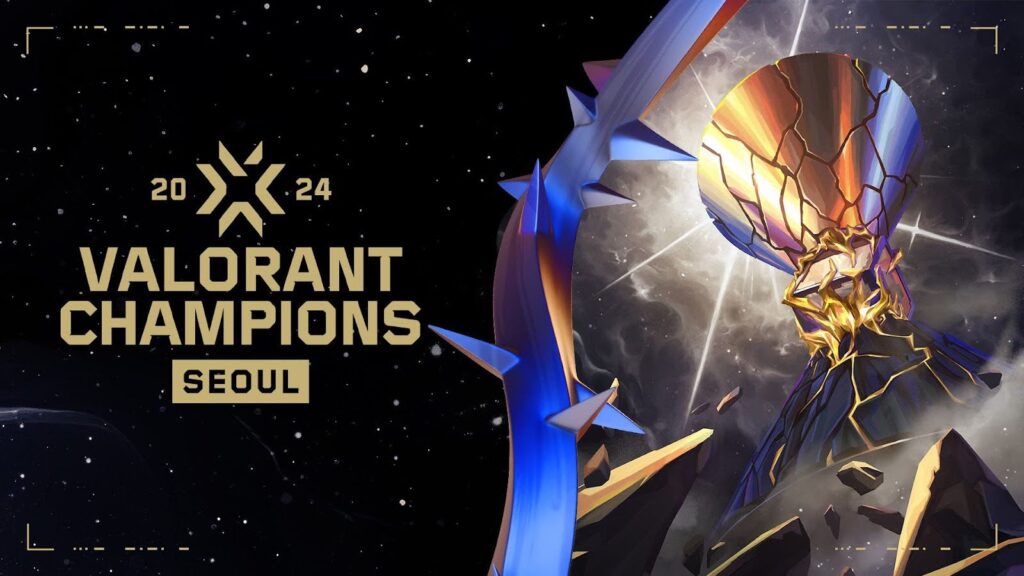
How teams & players progress in VALORANT Esports
Progression forward depends on the starting point of origin and whether or not a team or player is sponsored at a higher level. The path from a casual player to the VALORANT Esports champion starts with the division placement based on the matchmaking rating of the top five players.
There are six divisions: Open, Intermediate, Advanced, Elite, Contender, and Invite. By getting to this point, a team (or player) can progress forward to qualify for Challengers.
VALORANT teams can then play in the Challengers leagues, which is the next rung on the ladder towards the VCT. The Challengers leagues are split into three major regions, where it will then be a case of coming out on top against teams in territories such as America and Europe.
By toppling the competition, the team will be eligible to be hand-picked by Riot Games to compete in the VALORANT Champions Tour.
The VCT is the highest level of competition on the global stage in competitive VALORANT. Instead of playing regionally, this part of the process sees teams going against each other internationally, widening the skill ceiling (and upping the prize pool) significantly.
16 teams will then compete for the full purse. It was held throughout August in both Seoul and Incheon, South Korea. Given that millions of dollars are on the line, it’s a coveted (and difficult) dream to achieve.
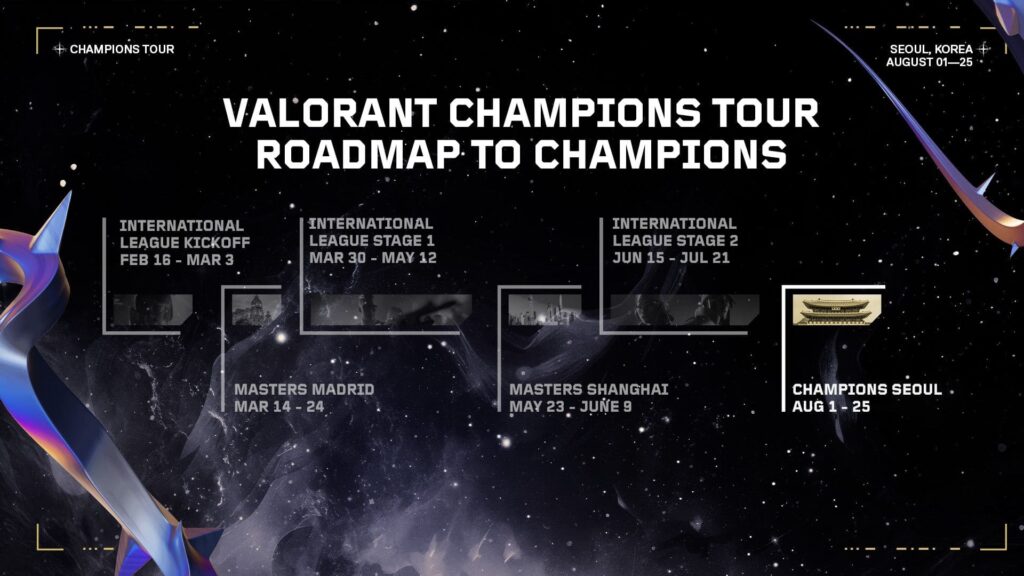
Franchise model vs. open circuit
Originally, the VCT was only made up of 30 franchised teams for the league format until early 2024, with 10 more teams added afterward. These new additions are now permanently a part of Tier 1. VALORANT franchising is where a spot is purchased on the roster through partnerships, which has allowed many teams to compete at the highest level. It’s the traditional approach for Esports teams.
In contrast, the Open VALORANT Circuit invites teams to “grind the road to pro” and has a much wider pool of teams competing for a shot at the title.
Franchising and open circuit teams do not typically mix, as the former is backed by corporate sponsorship, deals, and advertising money compared to the scrappier nature of playing on the open circuit, which is, inherently, free-for-all. Teams include Gen.G, Sentinels, OpTicc Gaming, LOUD, Evil Geniuses, Paper Rex, Acend, Zeta Division, Team International, Ninjas in Pyjamas, and Team Vikings.
VALORANT sponsorships are one of the most important factors in the high-end side of the tactical shooter at this level, paying towards all costs associated with the high-level events.
Some of the biggest names in VALORANT have major backing from hardware manufacturers, software companies, and other names in the gaming scene. For example, Sentinels is sponsored by Razer, Starforge System, and Zowie, whereas Fnatic is backed by Inzone, JackLinks, and Chillblast.
The most popular sponsors are Razer (which sponsors 18 teams), Red Bull (which sponsors eight), and Oakley (which backs three).
It’s not just gaming equipment and tech companies that are involved, as food and beverages, fashion, automobiles, and financial service providers are also involved in VALORANT Esports.
There are no betting or gambling sponsors for competitive VALORANT, which makes it quite different from the likes of CS2 and other Esports games that are funded that way. Riot Games has strict quality control over its sponsorship policies, rejecting gambling and crypto outright.
This has meant keeping things more advertiser-friendly, hence the larger pool of cash up from grabs at the end. Outside of sponsorship money, a major revenue stream is in-game cosmetics and streaming rights (through YouTube and Twitch).
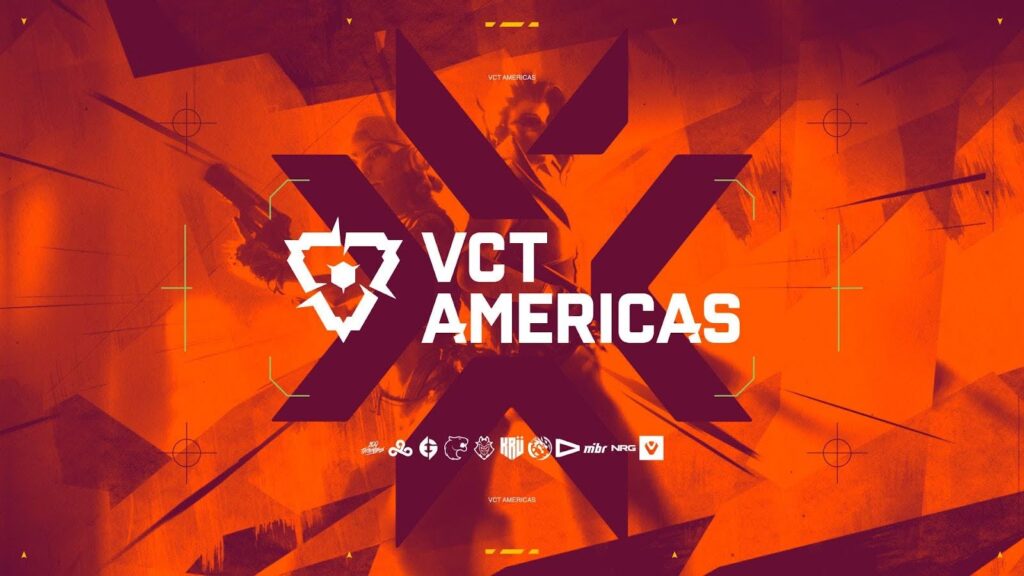
Prize pools & tournament winnings
The VALORANT Champions Tour has raked in the better part of $40,000,000 since it was introduced in 2020 (via Esports Charts). Throughout 2025 alone to date, there’s been nearly $1,000,000 in the prize pool, comprising a $500,000 winning pot at the VALORANT Masters Bangkok and $120,000 winnings at the APAC Predator League.
Looking back to previous years, 2024 saw nearly $9,000,000 in total winnings, with the VALORANT Champions event accounting for $2,250,000, the Masters Shanghai’s prize pot of $1,000,000, and the Masters Matrid pool of $500,000.
The most profitable year for VALORANT Esports to date was 2023, at nearly $9,500,000. Since 2020, there’s been a 250% increase in winnings from the first year’s total pool of $2,691,955, with 2025 on track to match (or possibly exceed) this amount.
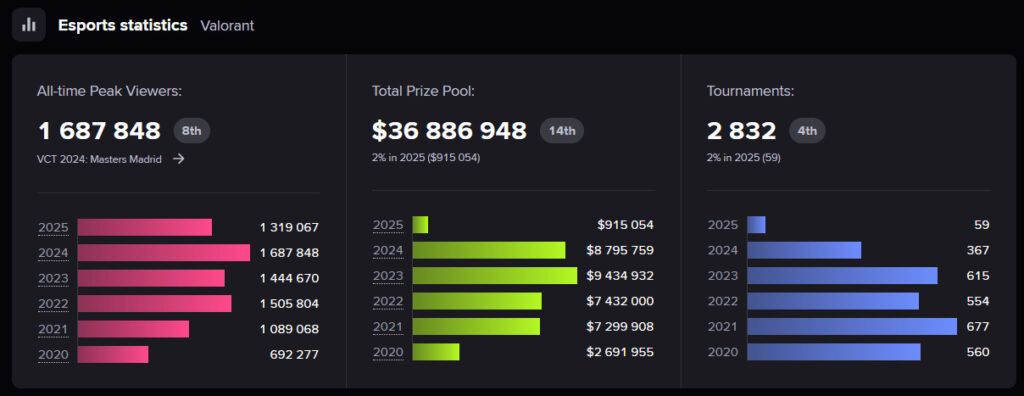
Media rights & broadcasting deals
VALORANT Esports events are viewed by an average of over one million people per event, which has steadily grown year-on-year as the prize pools have increased.
While 2020’s events had a total peak viewer count of 692,277, the number more than doubled in the following years, with 2025 already having 1,319,067 viewers and on track to be the highest-viewed year for the game yet.
Links to view VALORANT Esports matches can be found on its official website, with dedicated social media pages on Twitch, YouTube, and TikTok by spoken language; English, Portuguese, and Spanish are available via official channels.
For co-streaming, Riot Games has published guidelines for anyone wanting to stream the event themselves with considerations towards the Competition, Player Safety, Politics, and Competitive Integrity. Riot Games allows for the use of a Public Event Feed and license to distribute to the casting community.
The growth of VALORANT Esports teams
There are more VALORANT Esports teams in 2025 than ever, with viewership increasing alongside revenue and prize pool money. More sponsorships and players will only mean a bigger and better string of events for everyone.
Last year, Riot Games switched to prioritising regional events (bringing China into the fold), and the game is likely to explode more in this burgeoning market.
Competitive integrity & regulations
They have been regularly updated since 2022, 2023, 2024, and now 2025 with the Official Competition Ruleset outlined in a 45-page document going over the officially sanctioned equipment and peripherals, venue, competition area layout, schedule, match processes, post-match processes, pauses, bugs, exploit adjudication, travel expenses, change logs, and more.
The future of VALORANT Esports
The biggest development for the future of VALORANT Esports is a mobile version of the game, which is expected to come out soon. Some market estimates have claimed that VALORANT Mobile could be coming out in 2025 (starting in China), but we could see a launch date in 2026 (or beyond) to be rolled out to more players.
As a result, breaking into the cellphone market could see the game further explode in popularity and player count as its competitive scene may expand to Android and iOS instead of only PC, potentially allowing an install base of billions to get involved.
Conclusion
VALORANT Esports is one of the more exciting competitive games for either a player or a viewer and has grown successfully year-on-year in terms of reach, financial backing, and user count.
Nearly 5,000 players (and hundreds of teams) are looking to get involved through sponsorships or on the open circuit. Whether you’re an aspiring casual player looking to go pro or just an esports fan hoping to understand things better, our guide will be of help.
FAQs
The VALORANT Champions Tour is a global competitive esports tournament operated directly by Riot Games.
It’s believed that top-tier VALORANT pro players can make as much as $30,000 to $50,000 per month. However, entry-level pros make about $5,000 to $10,000 a month. Reportedly, some VALORANT streamers have made hundreds of thousands of dollars.
Joining a VALORANT Esports team isn’t easy, but you can increase your chances by focusing on your skills, networking with some of the game’s respected community members, taking part in amateur tournaments to get your name out there, and making a Player Profile before finally going for the Open Tryouts.
The VCT is separated into three distinct tiers: Challengers, Masters, and Champions. If teams can win on the regional circuit, they can go up to the higher level and then have a shot at winning the Champions for a multi-million dollar pot.
VALORANT Ascension is the last tournament of the Challengers bracket, where the winner of the six teams will advance from regional to international play.
References
- https://liquipedia.net/valorant/YFP/Lockdown_Arena/5 (Liquipedia)
- https://liquipedia.net/valorant/The_Reynas/2025/Resurrection (Liquipedia)
- https://valorantesports.com/en-US/news/everything-you-need-to-know-champions-seoul (Valorant Esports)
- https://escharts.com/games/valorant (Escharts)
- https://valorantesports.com/en-US/news/everything-you-need-to-know-champions-seoul (Valorant Esports)
- https://www.invenglobal.com/articles/19229/when-will-valorant-mobile-release (InvenGlobal)

